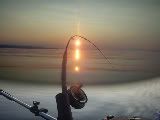quote:Originally posted by Kisinana
I heard that there was someone in the Mission Hatzic area raising in ponds. I don't remember much of the details but I think they were coho.
Just found this-I read about this guy selling to local restaurants.The article is a bit old-he is now successfully selling what you and I would call Baby Coho.
http://www.sfu.ca/pamr/news_releases/archives/news10190601.htm
Farming salmon in fresh water
October 19, 2006
Many say it can’t be done.
But Larry Albright, a recently retired marine microbiologist at Simon Fraser University, is proving that salmon — even the prized sockeye — can be farmed successfully in fresh water.
“All Pacific salmon, including sockeye, coho, chinook, chum and pink salmon can be cultured throughout their entire lifecycle in freshwater,” says Albright. The scientist has 17 years experience raising trout and now salmon in fresh-water fish farms and co-owns a fresh-water fish farm in Langley. “I have personally cultured the same stock of domesticated sockeye salmon through four sequential lifecycles in fresh water only.”
Speaking before the provincial government’s touring special committee on Sustainable Aquaculture on October 18, Albright went beyond explaining how salmon can be farmed in fresh water. He predicted that switching from conventional salmon farming in ocean-based netted pens to enclosed inland freshwater ones would have significant positive outcomes:
* Disease- and antibiotic-free: Unlike conventional commercial fish farms, fresh-water fish farms rarely use antibiotics and other chemotherapeutants because their ground-based water sources don’t have common pathogens.
* Improved public perception of fish farming: Inland and groundwater-fed fish farms are not mired in the controversy that shrouds ocean-based fish farming. Recent research done by other scientists at SFU and elsewhere demonstrates that ocean-based fish farming breeds sea lice in numbers that kill nearby juvenile wild salmon.
* Smaller ecological footprint: While ocean-based fish farms cover several kilometres of seacoast, a typical fresh-water farm occupies no more than five acres of land.
(electronic photo files available on request)
Larry Albright: Backgrounder
* Albright’s lab was the first to work out the sealice’s lifecycle. Albright chairs the B.C. Fresh Water Aquaculture Association. He is also voluntarily helping the N’quatqua Band in D’arcy, just north of Pemberton, B.C., run one of the province’s few commercial fresh water fish farms on native land.
* Albright says his main challenge in rearing fresh water salmon is getting them to market. While his fresh-water reared trout ends up on the tables of several high-end seafood restaurants in Vancouver, he has yet to pique the interest of seafood chefs in his fresh-water salmon. The fish are about a third smaller than their salt-water cousins and, similar to conventionally farmed salmon, their flesh is a less vibrant pink. Albright hopes to change popular perception that appetizing salmon has to be a certain size and colour.
* Albright estimates that the cost of commercially farming salmon in fresh water would be 1.3 times higher than the cost of commercially farming trout in fresh water.

